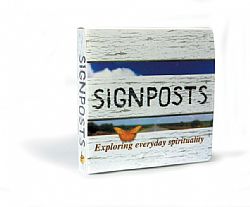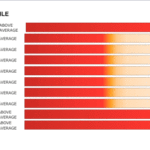Signpost Cards
Signpost cards, are a set of 48 cards developed by Russell Deal of Innovative Resources. They are based upon original photographs that that inspire exploration of the importance of purpose and belonging in our everyday lives.
Introduction
One of the most important, but regularly unspoken questions in a career counselling session is “what is the point?”. As Amundson (2009) points out clients often seek career counselling when they feel “stuck”. This sense of going nowhere can sometimes be the result of an obvious barrier, but frequently the reasons are more diffuse, and are connected to a lack of a sense of purpose, or a failure to appreciate what is personally meaningful or what matters most. Sometimes the people seek counselling for assistance in finding an outlet for their purpose.
Signposts cards are a resource that support the counsellor and client in bringing to the forefront and addressing issues relating to meaning and mattering. In so doing, these cards provide a valuable tool to have effective career conversations about topics that go to the heart of the idea of a fulfilling career.
Not all clients are ready to consider such weighty matters, and indeed sometimes clients may present as being suspicious of the whole counselling process, reluctant to cooperate or are by nature somewhat withdrawn. In some cases, a lack of cooperation can arise if there is a perceived power imbalance, for instance, when an authority figure like a Manager, Teacher, or older counsellor is working with a less senior client, or a younger person. Similarly if the client does not attend voluntarily, but presents to meet a requirement or perhaps at the behest of someone else like a partner or parent, this can be enough for them to be hesitant and untrusting in the early part of counselling.
Signpost cards, can be a useful ice-breaking device because they provide an immediate shared context between counsellor and client, and they move the focus of attention away from the counsellor-client interaction, to the cards themselves.
The extensive use of visual metaphors further reduces the pressure on the client to respond verbally, or extensively, and provides them with an alternative, ready made language in which to articulate their feelings. In this way, Signpost cards provided a valuable and flexible resource to begin and to foster meaningful career conversations.
Addressing what matters, and living with emergent meaning (from Pryor & Bright, 2004)
The Chaos Theory of Careers (Pryor and Bright, 2003ab, 2004, 2007, 2011; Bright and Pryor 2005, 2008) explicitly incorporates spirituality into career decision making. Bright, Pryor, Wilkenfeld and Earl (2005) reported that young Australians commonly offered spiritual reasons for their career decision making and behaviour. Savickas (1997) argues that the role of the Career Counsellor is to foster the client’s spirit.
By emphasising the complexity of influence on careers as well as the inherent uncertainty in all actions, the Chaos Theory of Careers provides a natural and inclusive home for both the rational and spiritual in career planning. Chaos theory is about what we know and do not and indeed cannot know; what we can control and what we cannot and will never, control – about confronting a dauntingly complex reality and instead of being intimidated being awestruck and humbled (Pryor & Bright, 2003 a,b).
Chaos Theory of Careers – a natural home for the spiritual in career planning
Chaos theory views reality in terms of complex dynamical systems which have a number of distinctive characteristics as a result of being complex, dynamical and systemic. Complexity is a recognition that reality has to be comprehended in its totality despite what challenges of investigation this poses (Lewin, 1951). The more complex chaotic systems are the more likely it is that random, unplanned, unpredicted events will begin to appear in the course of the functioning of the system. The unpredictability of the weather is a classic illustrative case. The dynamical nature of chaotic systems is a consequence of complex systems’ sensitivity to change that can be quite disproportionate to the alteration in the initial conditions. This is popularly known as “the butterfly effect” with the by line from the recent movie with that title “change one thing: change everything”. More serious contemporary examples are the impact a few terrorists may have on a whole continent and the computer virus on the Internet with the potential to bring down literally millions of computers worldwide, from perhaps only one gifted but maladjusted hacker.
Order and Disorder as composites and not opposites
Up to this point chaos theory may appear to be only about chaos or disorder, when in fact it is also about order (Kellert, 1993). The systemic component of chaos theory emphasises the interconnectedness of elements which when functioning as a system begin to display characteristics of pattern and order. Chaos theory recognises order as the emergent and often synergistic properties of systems’ functioning (Morowitz, 2002). The leaves on a particular species of gum tree all produce recognisably similar configurations of leaves. Order is a consequence of the boundedness of the functioning of a system. This is known in mathematical systems theory as the attractor. Chaos theory introduces the idea of the strange attractor which is essentially the self-organising patterning of a system which repeats itself but not in such a way that can always be predicted (Kellert, 1993). That is what it means to be a complex dynamical system. But where does this so-called “Theory of Everything” (Morowitz,2002) intersect with career development theory and practice and what are some of the consequent implications?
The accepted wisdom among psychologists used to be that these two domains of human experience do not have much overlap and that while psychology may contribute to the understanding of religious behaviour, spirituality really had nothing to tell hardnosed empiricists and conceptually confined theoreticians. In the career development field unless you were discussing careers in the clergy, spirituality was simply neglected or purposely omitted from consideration.
Perceiving, understanding and acting in the world
The resurgence of interest in spirituality in the general community is becoming increasingly reflected in the career development literature. Counselling strategies and assessment techniques abound which deal with spiritual concepts such as purpose, meaning, balance, harmony, passion, mission, commitment, contribution and integrity (Anderson, 1998; Bloch, 1997; Bolles, 2003; Johnston, 2000). Chaos theory stresses pattern and emergent order as characteristics of the functioning of complex dynamical systems. The pattern or fractal of a person’s life and career development, are functions of each individual’s strange attractor. The strange attractor can be understood in terms of what really matters to someone, their “ultimate concern”, the paradigm they have for perceiving, understanding and acting in the world. Thus chaos theory draws no distinction between the scientific and the spiritual. They are both elements in the functioning of the complex dynamical system that we call our human existence (Morowitz, 2002).
What is being claimed is not that all these new currents of thinking, conceptualising and counselling practice owe their origins to chaos theory. These new realities have derived principally from careers counsellors confronting the daily challenges of twenty-first century career development, not theorists. Rather, what is being claimed is that chaos theory can provide a coherent understanding of such new currents’ significance, their links to each other and to reality in general.
Signpost Cards (Russell Deal and Karen Masman, 2004)
The Signpost cards provide an interactive and natural way to address spiritual issues in careers. The cards are designed to “provide a simple set of prompts that can help us reflect on, and talk about, our search for meaning and significance”. As Deal and Masman point out there are no rules for using the cards, your imagination is the only limiting factor. Here though are some suggestions for using these in the context of vocational counselling. In all cases the cards can be used in group or individual counselling and / or teaching scenarios.
How to introduce the cards
Introduce the cards to a client or a group, with a brief background such as:
“These are a set of cards that contain statements about different aspects of life or values that important to many people. What I am interested in today, is which of the statements on these cards do you see as relevant to your past or future career. Remember there are no wrong or right answers here, all you are required to do is think about each statement on each card and consider how it relates to you and what is important to you”.
Here are some exercises for you to consider:
Cards that mean something to me.
Shuffle the cards in front of the client to convey that there is no pattern in the way the cards are displayed. Lay out the 48 cards in a 6 x 8 grid. Now ask the client to look at the cards and to select at least 2 or 3 and no more than 7 that jump out at them as saying something about their work values or their career. Ask the client to place these cards in front of them, and collect up the other cards so they do not distract the client.
Now, ask the client to consider each selected card in turn and ask them about why they selected the card. Some questions to prompt this include:
Why did you select that card?
Can you tell me a story about your work/career/life/experience that relates to this card?
How can you incorporate the statement on this card into your career / career plans / next job / life?
Can you see a pattern across the cards you have chosen? What is that pattern and how does it relate to your career?
Forced choice random pairs.
Take the pack of cards and shuffle them. Now deal two cards from the top of the deck. Ask the client to select one of those cards. After the selection, ask them why they chose the card they did, how it relates to their career, and how the statement might be useful in their future career. Repeat this process with the next 2 cards and so on
Your career story
Spread the cards out on a table and ask client to write down a story that reflects who they as a person and how their career has unfolded using the cards to reflect aspects of their career. They should make explicit reference to the cards, why they chose them and how they relate to their career.
Optional: Ask the client which essential plot (Pryor & Bright, 2008) applies: Rags to riches, Overcoming the monster, Voyage and Return, The Quest, Tragedy, Comedy or Rebirth. Then ask the client to re-cast the story within another plot.
Significant Others
Ask the client to repeat the “Cards that mean something to me” exercise, but on this occasion do it through the eyes of some significant other person – what cards would they decide mattered to the client?
Like / Dislike
Rapidly present one card at a time to the client and ask them whether they like the card or don’t like the card. Then place the cards in one of two piles for like or dislike. Alternatively you can get the client to do this themselves, but having the counsellor do it, is one way to maintain a rapid pace.
Once they’ve been sorted into two piles, take the like pile (which is normally a lot larger than the dislike pile), and spread all of the liked cards out on a large table so each can be seen clearly.
Now tell the client they have 1 minute to select their top favourites from the set. Make a point of timing them with a watch, stop watch or mobile phone timer.
Most clients will feel a little challenged by this exercise which why you impose the “strict” time limits. The idea is to encourage the client to make “hunch” or instinctive selections without overthinking their choices.
You may find that a client stubbornly refuses to choose only 10 and may pick 11, 12 or a couple more. This is fine. The main aim is to reduce the number of choices to a workable number.
Once these have been chosen, ask the client why they have chosen those particular cards. Typically clients will spontaneously commence explaining their choices, but same may need some prompting.
If appropriate write down their commentary. If the client has not spontaneously offered an explanation that links their choices together, next ask the client if they can see any common themes emerging from their selections.
Worked Example
Client A
Client A was sent to see me, and appeared reluctant and withdrawn. She was in her late teens and her parents were concerned about her disconnection with education and work. She had left school prematurely, and had worked in series of labouring roles that appeared to be well below her potential and that did not satisfy her.
Having initially tried to engage her in conversation about her past, it was evident she was not forthcoming, and maintained a very guarded and defensive attitude.
At this stage I introduced the cards by saying “Ok, I’d like you to have a look at these for me, and just pick out any that you like”. I deliberately underplayed the exercise in attempt to avoid provoking further suspicion or withdrawal.
As she sorted through the cards, I observed how she approached the task. It was apparent that she was quite engaged by the cards, and in particular made emphatic gestures of pushing away cards that she did not like.
From this (and her general demeanour) I formed the hypothesis that she was fairly sure of what she did not like, but was perhaps more tentative and unsure in deciding what she did like. I say this was a hypothesis as at this stage in the counselling session I want to explore and tentatively construct an understanding of the client. I try to stay as open as possible, and will often form several hypotheses, some (sometimes many) of which will prove to be wrong.
As she continued with the exercise, she began spontaneously to provide a commentary on her decisions. Once again the negative choices were more likely to accompany a commentary.
Interestingly perhaps half of her choices that she explained were based upon her responses to the imagery on the cards, rather than the written sentiment. Furthermore her responses were often related to the aesthetics of the cards – the layout, the colour schemes, the juxtapositions – rather than the meaning conveyed by the imagery.
Once she had completed the task, I asked her about her choices, and decided to start with those that she had rejected, because she seemed more comfortable talking about these negatives. This confirmed to me that she was operating from a heightened aesthetic sensitivity as she often described her responses in terms of her emotional responses to visual imagery.
This is in turn lead into a discussion of Art and it transpired that she had spontaneously enrolled in an Arts night school course, but had withdrawn after her parents criticised her choice as being “impractical”.
From this point she began to open up and told a story of dominant parents who had strongly encouraged her to study subjects that would lead her to working as a Personal Assistant – the same role her Mother had occupied for many years. However she had no interest in this area, but was very interested in the Arts at school, and had done well in this subject in school until her parents had encouraged her to drop it.
It was at this time her interest in school began to wane, and she began to feel alienated from her parents and other friends who “did not understand” her.
Despite her apparent interests, she had not made the link between her interests and careers. Indeed she had been rather more preoccupied with the sense of rejection and alienation from those closest to her, and had not given much thought to how career choices may play a role in resolving the conflict and providing a viable outlet for her passion.
From this point on the counselling session was transformed as she opened up more, and became more trusting that she could express her interests in this area without fear of criticism or introduction of discussion of “practicalities” – a term apparently used often by her parents. This in turn lead to the development of plans and ideas about her finding ways of pursuing these interests and the sorts of courses that she might enrol in.
As this process continued, she developed sufficient confidence to explain her situation to her parents, who she found to be surprisingly supportive and agreeable. Once they appreciated that her interests were soundly based and genuine, they had a new perspective from which to view her apparently “antagonistic” behaviour.
Purchase Signposts Cards
The cards can be purchased from Bright and Associates here
References
Amundson, N. (2009). Active Engagement. Ergon Publications. Richmond, BC.
Bloch, D. P., & Richmond, L. J. (Eds.). (1997). Connections between spirit & work in career development. Palo Alto, CA: Davies-Black.
Bolles, R. (2003). What color is your parachute. Berkley, CA: Ten Speed.
Bright, J. E. H., & Pryor, R. G. L. (2005). The chaos theory of careers: A user’s guide. Career Development Quarterly, 53(4), 291–305.
Bright, J.E.H. & Pryor, R.G.L.. (2008). Shiftwork: A Chaos Theory Of Careers Agenda For Change In Career Counselling. Australian Journal of Career Development. 17(3), 63-72
Bright, J.E.H., Pryor, R.G.L., Wilkenfeld, S and Earl, J. (2005). Influence of social context on career decision-making. International Journal for Educational and Vocational Guidance, 5 (1),19 – 36
Johnston, G. (2000). Aligning your work and purpose: Step out to an abundant life. Melbourne, Vic: Information Australia.
Kellert, S. (1993). In the wake of chaos: Unpredictable order in dynamical systems. Chicago, Ill: University of Chicago Press.
Lewin, K. (1951). Field theory in social science; Selected theoretical papers. D. Cartwright (Ed.). New York, NY: Harper & Row
Morowitz H.J. (2002). The emergence of everything: How the world became complex. New York: Oxford University Press.
Pryor, R. G. L., & Bright, J. E. H. (2003a). The chaos theory of careers. Australian Journal of Career Development, 12(2), 12–20.
Pryor, R. G. L. & Bright, J. E. H. (2003b). Order and chaos: a twenty-first century formulation of careers. Australian Journal of Psychology, 55(2), 121-128.
Pryor, R. G. L., & Bright J. E. H. (2004). ‘I had seen order and chaos but had thought they were different.’ Challenges of the Chaos Theory for Career Development. Australian Journal of Career Development, 13(3). 18–22.
Pryor, R. G. L., & Bright J. E. H. (2007). Applying chaos theory to careers: Attraction and attractors. Journal of Vocational Behavior, 71(3), 375–400.
Pryor, R. G. L., & Bright J. E. H. (2008). Archetypal narratives in career counselling: A chaos theory application. International Journal for Educational and Vocational Guidance, 8(2), 71–82.
Pryor and Bright 2011. The Chaos Theory of Careers. Routledge. New York.
Savickas, M.L. (1997). Fostering the spirit in career development. In D.Bloch & L. Richmond. (Eds). Connections between spirit & work in career development. Palo Alto, CA: Davies-Black.
Related Posts













Pingback: Tweets that mention Using Signpost cards to understand passion, purpose and values | The Factory -- Topsy.com
Pingback: Five ways to resoul your career | The Factory